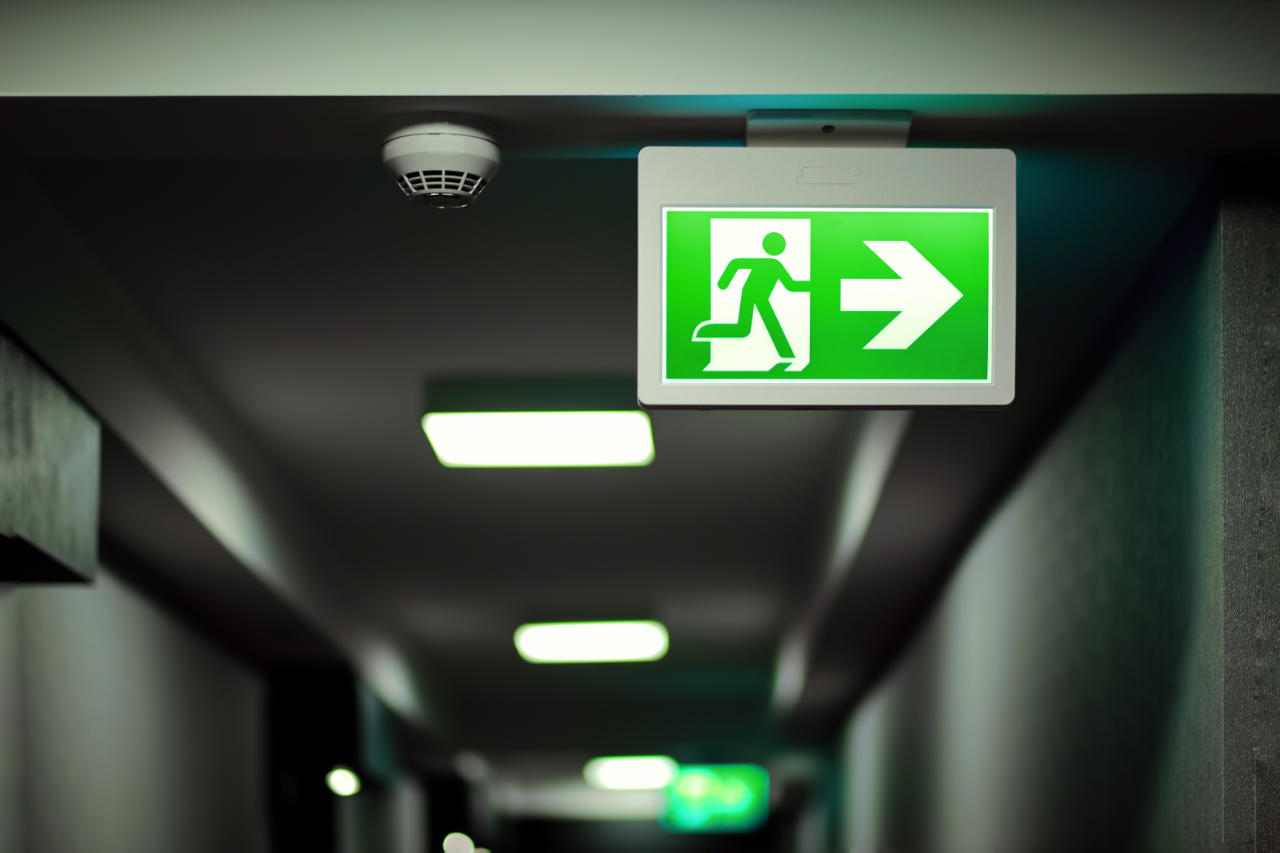
Business and property owners must protect those who work for them and enter the premises from harm, including harm that could be caused by fire. With extended periods spent in workspaces and the most common risk to employees being poorly planned escape routes, having the correct fire signage is vital to ensure safety and meet UK legislation.
Why you need fire safety signs
All businesses are legally obligated to protect their employees’ physical and mental health and well-being from harm, including mitigating the risk of fire.
There are two critical pieces of UK health and safety legislation regarding fire safety – The Regulatory Reform (Fire Safety) Order 2005 (also known as ‘The RRO’) and The Health and Safety (Safety Signs and Signals) Regulations 1996.
The RRO collates all fire safety requirements into one piece of legislation, while The Health and Safety (Safety Signs and Signals) Regulations 1996 are specifically about fire safety signs.
These legislations state that all workplaces must have fire safety signs to warn and instruct employees in the event of a fire incident. These signs should be used in conjunction with fire safety training.
Find out more about Praxis42’s Fire Safety Training which has been developed by our highly respected fire safety consultants who have extensive experience in the field.
What are the rules on fire safety signs?
The Health and Safety (Safety Signs and Signals) Regulations 1996 outlines the rules and requirements concerning signs, particularly related to which signs should be used and how they should be displayed:
- Fire safety signs should be obvious and clear – they should be placed where they are easy to see and effectively indicate key information such as fire exits and escape routes.
- Escape route signs must line the entire exit route – fire safety signs should be placed along the whole escape route, including on doors, in corridors and stairwells, in open spaces, and above junctions to indicate an escape route.
- Fire safety signs must be illuminated – fire safety signs must always be easily visible and legible. Ensuring fire safety signs are permanently illuminated, such as using lights powered by batteries or glow-in-the-dark materials that help retain visibility if power is lost but would still need to be illuminated by an emergency light source whether in the sign or in close proximity.
- Escape routes must be obviously marked – to avoid confusion and mitigate risk, escape routes must be clearly signed and highlight clearly the way to exit the building.
- Directional arrows should be used to direct people to safety – directional arrows can help give clear, easily visible instructions towards the most efficient route in a fire emergency.
- Signs should be displayed at the appropriate height – fire safety signs must be easily visible from a distance. Fire safety signs placed above doors or suspended from the ceiling should be 2m above the floor and 2m above the floor when attached to walls.
- Fire escape route signs should be in pictorial form and can have additional text – fire safety signs must be accessible to all, meaning additional text to the image sign can also ensure that the sign’s message is clearly understood. As stated in The Equality Act 2010, “reasonable adjustments” must be made for those who have disabilities, which include providing Braille translations and tactile fire safety signage alongside standard ones.
- Signs must be used to identify fire-fighting equipment – fire safety signs should be used to indicate the location of fire safety equipment, such as fire extinguishers if they are not easily visible. Signage is also needed to provide information on what class of fires the extinguishers can and cannot be used on.
Read our guide on the benefits of fire safety training.
Types of fire safety signs and their meanings
The BS EN ISO 7010 standard was drafted to create an internationally-recognised, standardised look for all fire safety signs. This was designed to avoid confusion on the meaning of different signs worldwide and improve fire safety.
Mandatory signs
Mandatory fire safety signs are essential to having a comprehensive and effective fire safety management system in place.
Coloured blue and either circular or rectangular, these fire safety signs state actions that must be carried out to comply with safety regulations and improve fire safety.
A neutral shade compared to red or yellow, blue is used for these signs to not negatively impact the meaning of warning or prohibition signs.
Common examples of this type of fire safety sign include:
- A blue, circular sign with a white exclamation point in the middle. Below is an additional blue rectangular sign that states, “Fire door, keep shut”. This sign is designed to comply with legislation.
- Two blue rectangles on a white background with the header “Fire instructions for staff” and a list of action points to be undertaken by employees in the event of a fire emergency displayed in white text. These signs are known as Fire Action Notices.
- A blue circular sign with white text that may read “Fire door, keep closed”, “Fire exit, keep clear”, “Automatic fire door, keep clear”, or a variation of this.

Read our guide on fire safety in the workplace.
Emergency escape signs
Also known as Safe Condition Signs, these signs indicate emergency exits and fire evacuation assembly points and direct employees along fire escape routes. These signs are predominantly green with white text or images in the centre and come in square or rectangular form.
Like green traffic lights, the green sign colour encourages action.
Common examples of emergency escape signs include:
- A green figure moving through a white doorway next to a white arrow pointing towards the fire escape. The direction of the arrow will vary depending on where the sign is placed.
- A green figure moving through a white doorway, away from white flames behind them.
- Four white figures in the centre with four white arrows pointing at them on a green background. Sometimes this sign also includes the text “Fire Assembly Point” beneath the figures.

Prohibition signs
Red prohibition signs inform people of behaviour they should not engage in, as it could increase the fire risk. They are circular signs that contain no text – only a black image in the centre surrounded by a red circular outline.
Red is the colour most commonly associated with danger, making it the logical choice to discourage potentially dangerous behaviour.
Typical examples of this type of fire safety sign include:
- A black smoking cigarette on a white background with a thick red line through it.
- Two people standing in a lift with flames to the right on a white background with a thick red line through the image.
Warning signs
The purpose of these triangular fire safety signs is to highlight a potential fire-related hazard, such as a flammable substance. These signs are bright yellow with a solid black border and a black image in the centre. These signs also sometimes appear rectangular.
These signs are bright yellow so that they can be very easily seen, but they also mimic natural colours that indicate danger.
Common examples of warning fire safety signs include:
- A black blaze with a black line beneath it on a yellow background.
- A yellow rectangle with the text “Warning: fire risk” or “Danger: fire risk” written in black text.
These two signs can often be found paired together.
Fire equipment signs
Like warning signs, fire equipment signs are also coloured red and white.
However, these signs indicate the location of fire safety and fire fighting equipment, such as fire extinguishers and fire alarm call points. They are square-shaped and found next to the equipment they depict.
Just like warning signs, they are coloured red to indicate danger and be easy to spot.
Common fire equipment signs include:
- A white hand pointing to a white button with white flames on the right on a red background. This sign can also contain text that reads “Fire alarm”.
- A white fire extinguisher with white flames on the right on a red background.
- A white coiled hose hanging beside white flames on the right on a red background.
- On a red background, a white firefighter helmet with white flames to the right. Text below the image will read “Fire point”.
Fire Safety Training
Developed by our experienced fire safety consultants, our Fire Safety Training helps ensure your organisation complies with the Regulatory Reform (Fire Safety) Order and supports employees to understand fire hazards, how to prevent fires and what to do in an emergency.
We also offer Fire Marshal Training which covers everything in the Fire Safety course plus the additional knowledge fire marshals specifically need for their role.

Rob Sherman
Director of Fire Safety
